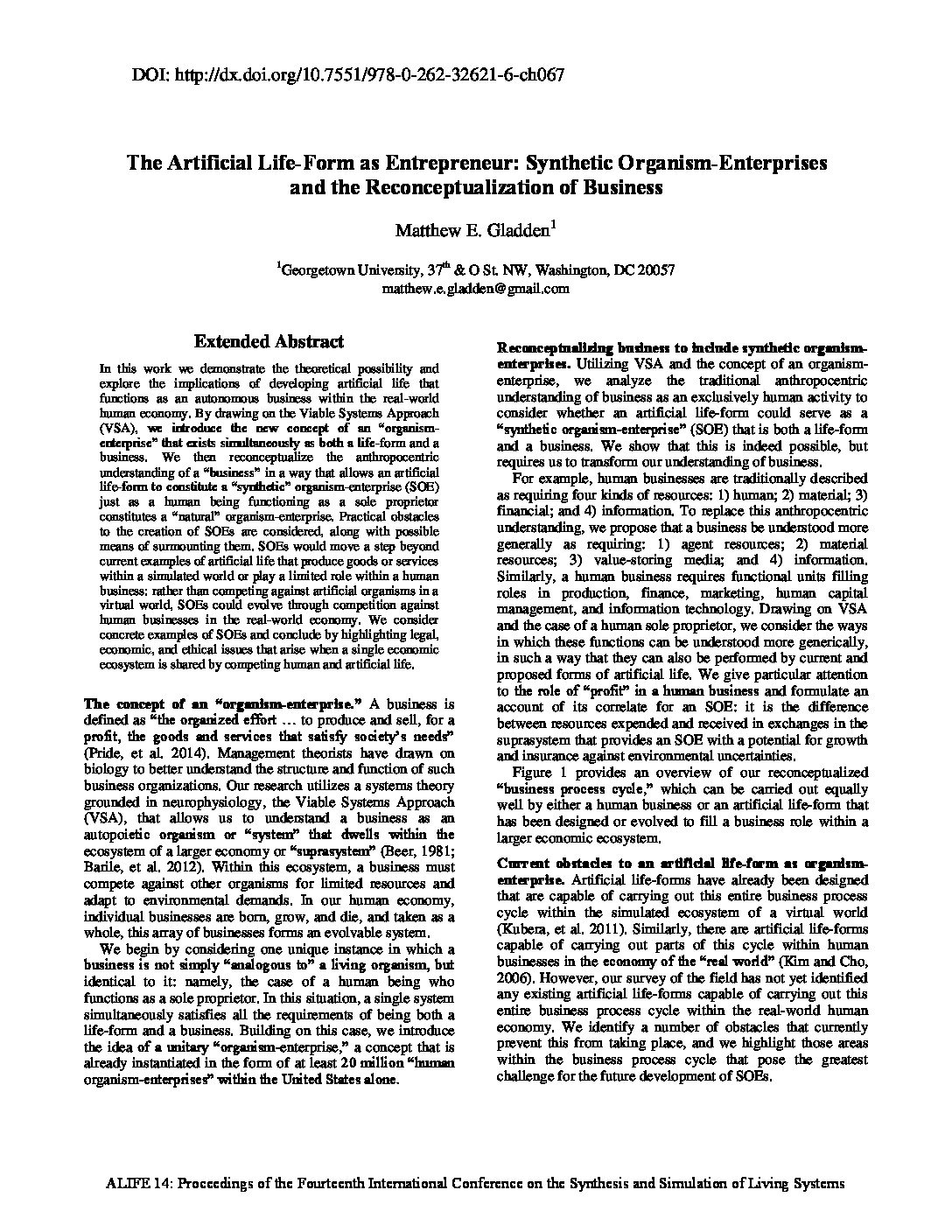
In Proceedings of the Fourteenth International Conference on the Synthesis and Simulation of Living Systems, edited by Hiroki Sayama, John Rieffel, Sebastian Risi, René Doursat and Hod Lipson, pp. 417-18 • Cambridge, MA: The MIT Press, 2014
ABSTRACT: In this work we demonstrate the theoretical possibility and explore the implications of developing artificial life that functions as an autonomous business within the real-world human economy. By drawing on the Viable Systems Approach (VSA), we introduce the new concept of an “organism-enterprise” that exists simultaneously as both a life-form and a business. We then reconceptualize the anthropocentric understanding of a “business” in a way that allows an artificial life-form to constitute a “synthetic” organism-enterprise (SOE) just as a human being functioning as a sole proprietor constitutes a “natural” organism-enterprise. Practical obstacles to the creation of SOEs are considered, along with possible means of surmounting them. SOEs would move a step beyond current examples of artificial life that produce goods or services within a simulated world or play a limited role within a human business: rather than competing against artificial organisms in a virtual world, SOEs could evolve through competition against human businesses in the real-world economy. We consider concrete examples of SOEs and conclude by highlighting legal, economic, and ethical issues that arise when a single economic ecosystem is shared by competing human and artificial life. The concept of an “organism-enterprise.” A business is defined as “the organized effort … to produce and sell, for a profit, the goods and services that satisfy society’s needs” (Pride, et al. 2014). Management theorists have drawn on biology to better understand the structure and function of such business organizations. Our research utilizes a systems theory grounded in neurophysiology, the Viable Systems Approach (VSA), that allows us to understand a business as an autopoietic organism or “system” that dwells within the ecosystem of a larger economy or “suprasystem” (Beer, 1981; Barile, et al. 2012). Within this ecosystem, a business must compete against other organisms for limited resources and adapt to environmental demands. In our human economy, individual businesses are born, grow, and die, and taken as a whole, this array of businesses forms an evolvable system.
We begin by considering one unique instance in which a business is not simply “analogous to” a living organism, but identical to it: namely, the case of a human being who functions as a sole proprietor. In this situation, a single system simultaneously satisfies all the requirements of being both a life-form and a business. Building on this case, we introduce the idea of a unitary “organism-enterprise,” a concept that is already instantiated in the form of at least 20 million “human organism-enterprises” within the United States alone. Reconceptualizing business to include synthetic organism-enterprises. Utilizing VSA and the concept of an organism-enterprise, we analyze the traditional anthropocentric understanding of business as an exclusively human activity to consider whether an artificial life-form could serve as a “synthetic organism-enterprise” (SOE) that is both a life-form and a business. We show that this is indeed possible, but requires us to transform our understanding of business. For example, human businesses are traditionally described as requiring four kinds of resources: 1) human; 2) material; 3) financial; and 4) information. To replace this anthropocentric understanding, we propose that a business be understood more generally as requiring: 1) agent resources; 2) material resources; 3) value-storing media; and 4) information. Similarly, a human business requires functional units filling roles in production, finance, marketing, human capital management, and information technology.
Drawing on VSA and the case of a human sole proprietor, we consider the ways in which these functions can be understood more generically, in such a way that they can also be performed by current and proposed forms of artificial life. We give particular attention to the role of “profit” in a human business and formulate an account of its correlate for an SOE: it is the difference between resources expended and received in exchanges in the suprasystem that provides an SOE with a potential for growth and insurance against environmental uncertainties. Figure 1 provides an overview of our reconceptualized “business process cycle,” which can be carried out equally well by either a human business or an artificial life-form that has been designed or evolved to fill a business role within a larger economic ecosystem.
Read more















